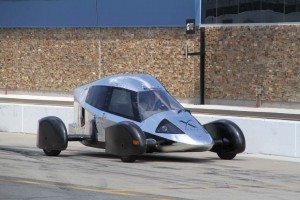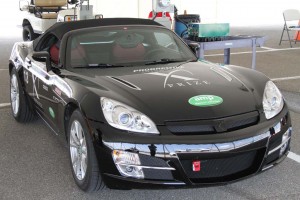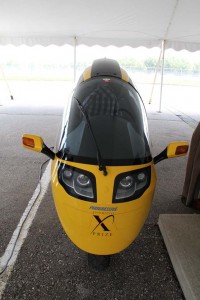
Theirs to lose...the Edison2 Very Light Car, likely winner of the $5 million Progressive Auto X-Prize mainstream award.
With the final stage fast approaching in the long and grueling Progressive Auto X-Prize competition, it’s now up to just one team to hold things together long enough to claim $5 million in cash, organizers have announced.
The X-Prize, designed to prove it possible to produce an attractive and affordable mainstream car capable of getting 100 miles per gallon may be demonstrating exactly the opposite. One after another, promising designs and technologies simply haven’t been able to live up to the challenges set by organizers who were hoping to show that lean and green automobiles are ready for prime time.
Following the past week’s shake-out, with only a few hurdles left before the awards are formally announced, in Washington, D.C., in September, two vehicles survive in the tough mainstream class. Both are fielded by the Edison2 team, which is led by European car dealer Oliver Kuttner, and brings together an assortment of motorsports and defense specialists.
But there’s still a bitter battle underway between more than a dozen teams hoping to claim a pair of $2.5 million prizes for alternative, high-mileage vehicles.
Modeled after the Orteig Prize, which helped motivate Charles Lindbergh’s legendary trans-Atlantic flight – and the Ansari X-Prize which spurred the first private manned spaceflight, in 2004 – the Progressive Auto X-Prize was designed to encourage the development of clean, high-efficiency vehicles.
But the goal, stresses Eric Cahill, an energy researcher and now the senior director of the Auto X-Prize, has been to do more than just reward a brilliant piece of technology that could never make it into production. Each of the 115 teams that originally signed up for the competition has not only had to meet strict technical mandates, but also prove that it could mass produce its entry at an affordable price — and demonstrate why the offering would actually generate a market.
Ironically, when the project was first announced, in April 2008, “We were getting criticized for making it seem too easy,” says Cahill. “Many thought that getting the equivalent of 100 miles per gallon wouldn’t be a problem.”

Amp opted for a relatively conventional Saturn Sky converted to electric power -- but missed the minimum requirements.
It hasn’t proved to be easy at all, especially in the Mainstream category, where technical requirements include not only the equivalent of 100 mpg – a figure that can be adjusted to reflect the use of alternative fuels or battery power – but 200 miles range, the ability to meet federal safety standards and all the while carry four passengers.
Since the first round of so-called “shakedown” testing began, one team after another has been eliminated. Today, only Edison2, with two copies of its Very Light Car, remains. But the two identical vehicles underscore just how tough a challenge faces those who see the Auto X-Prize as a goal, rather than a fantasy.
While some entries in the Progressive Auto X-Prize look fairly conventional, such as the battery-powered Saturn Sky entered by Amp, Edison2’s VLC looks more like an exotic race car than something you’d find at your local dealer. The overall carbon fiber body is teardrop-shaped to maximize aerodynamics, and the wheels sit outboard, like a Formula One racer. The VLC’s drag coefficient is a mere 0.15, barely half that of the most efficient passenger cars now in mass production.
The entire vehicle weighs in at just 750 pounds, which permits designers to run it on a modest 250cc Yamaha motorcycle engine, powered by E85 ethanol.

One of the most unusual entries into the competition, the 2-wheeled, Swiss-made X Tracer will likely win the Alternative/Tandem class.
One of the most intriguing features of the VLC is the design of the front suspension – with its feather-light 6-pound wheels – which can serve as a collapsible, force-absorbing structure in the event of a crash.
“It’s theirs to win, “ says Cahill, “or lose,” he adds, as a quick reminder that there are still several steps in the X-Prize process before judges name the winners.
Along with the $5 million for the best mainstream entry to meet the X-Prize targets, the competition will award two $2.5 million prizes for alternative vehicle entries. If Edison2’s VLC seems a stretch of the imagination, the word, automobile, doesn’t readily connect with the X-Tracer, the entry from a Swiss team that is, fundamentally, a motorcycle with a crash-resistant shell. Barely squeaking in under a generous reading of the rules, it seems the entry to beat in the Alternative/Tandem category.
Amp’s modified Saturn Sky was one of the most conventional offerings in the Alternative/Side-by-Side categories.
“Our approach was to say that this is a car available today and that’s as safe as any car on the road,” explained team member Marty Rucidlo. In hindsight, he concedes, the electric vehicle maker might have done even better entering a battery-powered Chevrolet Equinox which would have had enough seats to qualify for the mainstream category.
But even defeat in the X-Prize carries some glory, insists Alex Campbell, one of the founders of the California battery car maker, Zap, which is hoping to ride the wave of interest in electric propulsion.
“We’ve been on the outside looking in,” says Campbell, “but maybe the X-Prize can open doors and get us taken more seriously.”
